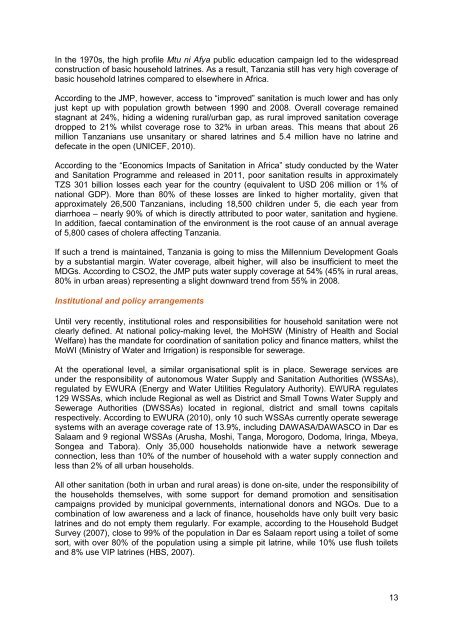REPORT__Evaluating_the_potential_of_microfinance_for_sanitation_in_Tanzania_May_2013
REPORT__Evaluating_the_potential_of_microfinance_for_sanitation_in_Tanzania_May_2013
REPORT__Evaluating_the_potential_of_microfinance_for_sanitation_in_Tanzania_May_2013
You also want an ePaper? Increase the reach of your titles
YUMPU automatically turns print PDFs into web optimized ePapers that Google loves.
In <strong>the</strong> 1970s, <strong>the</strong> high pr<strong>of</strong>ile Mtu ni Afya public education campaign led to <strong>the</strong> widespread<br />
construction <strong>of</strong> basic household latr<strong>in</strong>es. As a result, <strong>Tanzania</strong> still has very high coverage <strong>of</strong><br />
basic household latr<strong>in</strong>es compared to elsewhere <strong>in</strong> Africa.<br />
Accord<strong>in</strong>g to <strong>the</strong> JMP, however, access to “improved” <strong>sanitation</strong> is much lower and has only<br />
just kept up with population growth between 1990 and 2008. Overall coverage rema<strong>in</strong>ed<br />
stagnant at 24%, hid<strong>in</strong>g a widen<strong>in</strong>g rural/urban gap, as rural improved <strong>sanitation</strong> coverage<br />
dropped to 21% whilst coverage rose to 32% <strong>in</strong> urban areas. This means that about 26<br />
million <strong>Tanzania</strong>ns use unsanitary or shared latr<strong>in</strong>es and 5.4 million have no latr<strong>in</strong>e and<br />
defecate <strong>in</strong> <strong>the</strong> open (UNICEF, 2010).<br />
Accord<strong>in</strong>g to <strong>the</strong> “Economics Impacts <strong>of</strong> Sanitation <strong>in</strong> Africa” study conducted by <strong>the</strong> Water<br />
and Sanitation Programme and released <strong>in</strong> 2011, poor <strong>sanitation</strong> results <strong>in</strong> approximately<br />
TZS 301 billion losses each year <strong>for</strong> <strong>the</strong> country (equivalent to USD 206 million or 1% <strong>of</strong><br />
national GDP). More than 80% <strong>of</strong> <strong>the</strong>se losses are l<strong>in</strong>ked to higher mortality, given that<br />
approximately 26,500 <strong>Tanzania</strong>ns, <strong>in</strong>clud<strong>in</strong>g 18,500 children under 5, die each year from<br />
diarrhoea – nearly 90% <strong>of</strong> which is directly attributed to poor water, <strong>sanitation</strong> and hygiene.<br />
In addition, faecal contam<strong>in</strong>ation <strong>of</strong> <strong>the</strong> environment is <strong>the</strong> root cause <strong>of</strong> an annual average<br />
<strong>of</strong> 5,800 cases <strong>of</strong> cholera affect<strong>in</strong>g <strong>Tanzania</strong>.<br />
If such a trend is ma<strong>in</strong>ta<strong>in</strong>ed, <strong>Tanzania</strong> is go<strong>in</strong>g to miss <strong>the</strong> Millennium Development Goals<br />
by a substantial marg<strong>in</strong>. Water coverage, albeit higher, will also be <strong>in</strong>sufficient to meet <strong>the</strong><br />
MDGs. Accord<strong>in</strong>g to CSO2, <strong>the</strong> JMP puts water supply coverage at 54% (45% <strong>in</strong> rural areas,<br />
80% <strong>in</strong> urban areas) represent<strong>in</strong>g a slight downward trend from 55% <strong>in</strong> 2008.<br />
Institutional and policy arrangements<br />
Until very recently, <strong>in</strong>stitutional roles and responsibilities <strong>for</strong> household <strong>sanitation</strong> were not<br />
clearly def<strong>in</strong>ed. At national policy-mak<strong>in</strong>g level, <strong>the</strong> MoHSW (M<strong>in</strong>istry <strong>of</strong> Health and Social<br />
Welfare) has <strong>the</strong> mandate <strong>for</strong> coord<strong>in</strong>ation <strong>of</strong> <strong>sanitation</strong> policy and f<strong>in</strong>ance matters, whilst <strong>the</strong><br />
MoWI (M<strong>in</strong>istry <strong>of</strong> Water and Irrigation) is responsible <strong>for</strong> sewerage.<br />
At <strong>the</strong> operational level, a similar organisational split is <strong>in</strong> place. Sewerage services are<br />
under <strong>the</strong> responsibility <strong>of</strong> autonomous Water Supply and Sanitation Authorities (WSSAs),<br />
regulated by EWURA (Energy and Water Utilities Regulatory Authority). EWURA regulates<br />
129 WSSAs, which <strong>in</strong>clude Regional as well as District and Small Towns Water Supply and<br />
Sewerage Authorities (DWSSAs) located <strong>in</strong> regional, district and small towns capitals<br />
respectively. Accord<strong>in</strong>g to EWURA (2010), only 10 such WSSAs currently operate sewerage<br />
systems with an average coverage rate <strong>of</strong> 13.9%, <strong>in</strong>clud<strong>in</strong>g DAWASA/DAWASCO <strong>in</strong> Dar es<br />
Salaam and 9 regional WSSAs (Arusha, Moshi, Tanga, Morogoro, Dodoma, Ir<strong>in</strong>ga, Mbeya,<br />
Songea and Tabora). Only 35,000 households nationwide have a network sewerage<br />
connection, less than 10% <strong>of</strong> <strong>the</strong> number <strong>of</strong> household with a water supply connection and<br />
less than 2% <strong>of</strong> all urban households.<br />
All o<strong>the</strong>r <strong>sanitation</strong> (both <strong>in</strong> urban and rural areas) is done on-site, under <strong>the</strong> responsibility <strong>of</strong><br />
<strong>the</strong> households <strong>the</strong>mselves, with some support <strong>for</strong> demand promotion and sensitisation<br />
campaigns provided by municipal governments, <strong>in</strong>ternational donors and NGOs. Due to a<br />
comb<strong>in</strong>ation <strong>of</strong> low awareness and a lack <strong>of</strong> f<strong>in</strong>ance, households have only built very basic<br />
latr<strong>in</strong>es and do not empty <strong>the</strong>m regularly. For example, accord<strong>in</strong>g to <strong>the</strong> Household Budget<br />
Survey (2007), close to 99% <strong>of</strong> <strong>the</strong> population <strong>in</strong> Dar es Salaam report us<strong>in</strong>g a toilet <strong>of</strong> some<br />
sort, with over 80% <strong>of</strong> <strong>the</strong> population us<strong>in</strong>g a simple pit latr<strong>in</strong>e, while 10% use flush toilets<br />
and 8% use VIP latr<strong>in</strong>es (HBS, 2007).<br />
13


